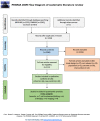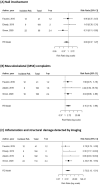Predictors, Risk Factors, and Incidence Rates of Psoriatic Arthritis Development in Psoriasis Patients: A Systematic Literature Review and Meta-Analysis
- PMID: 34596875
- PMCID: PMC8572278
- DOI: 10.1007/s40744-021-00378-w
Predictors, Risk Factors, and Incidence Rates of Psoriatic Arthritis Development in Psoriasis Patients: A Systematic Literature Review and Meta-Analysis
Abstract
Background: Agreement on how to identify psoriasis (PsO) patients at risk of developing psoriatic arthritis (PsA) is lacking.
Objective: To identify predictors, risk factors and incidence rate (IR) of PsA development in PsO patients through a systematic literature review (SLR) and meta-analyses (MA).
Methods: MEDLINE, Embase, and Cochrane databases were searched. Cohort studies were used to assess the predictors, while case-control studies for PsA risk factor determination.
Results: We screened 4698 articles for eligibility, and 110 underwent a full reading and 26 were finally included. Among skin and nail phenotypes, PsO severity and nail pitting were selected as predictors of PsA development. Furthermore, PsO patients with arthralgia (pooled RR 2.15 [1.16; 3.99]) and/or with imaging-MSK inflammation (pooled RR 3.72 [2.12; 6.51]) were at high risk of PsA. Higher categories of BMI and a family history of PsA were other predictors. In outpatient-based cohort studies, the IR of PsA per 100 patient-years varied from 1.34 to 17.4.
Limitations: Despite the strength of the overall results, the heterogeneity and the number of the cohort studies could be considered a limitation.
Conclusions: This study provides a tentative profile of the PsO patient at risk of PsA and will help the design of PsA prevention trials.
Keywords: Disease interception; Disease prevention; Early psoriatic arthritis; Psoriasis; Psoriatic arthritis; Systematic review.
© 2021. The Author(s).
Figures



References
-
- Christophers E, Barker JNWN, Griffiths CEM, Daudén E, Milligan G, Molta C, et al. The risk of psoriatic arthritis remains constant following initial diagnosis of psoriasis among patients seen in European dermatology clinics. J Eur Acad Dermatol Venereol. 2010;24:548–554. doi: 10.1111/j.1468-3083.2009.03463.x. - DOI - PubMed
Publication types
LinkOut - more resources
Full Text Sources
Research Materials
Miscellaneous

